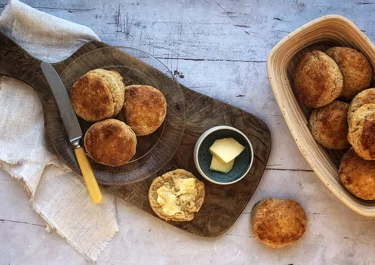Scones

Scones are a true British classic! They are quick and easy to make – and since they are made using baking powder, there is no need to wait while they rise! Serve for breakfast or as part of an afternoon tea with traditional sides like jam, clotted cream, and lemon curd, or mix it up by using your favourite spread on top.
Ingredients
|
550 g
Flour
|
|
|---|---|
|
75 g
Sugar
|
|
|
2 tbsp
Baking powder
|
|
|
1 tsp
Coarse salt
|
|
|
200 g
Cold butter
|
|
|
350 ml
Milk or buttermilk
|
|
|
Eggs for brushing
|
Instructions
Tips
To get the right flaky and airy texture, use cold butter and be careful not to overwork the dough. Overworking a scone dough will make it dense, giving it a tough texture that is not nearly as nice to bite into. Gently combine the dough with your hands, stopping as soon as it looks even.
Tips
Cold butter will also help you achieve this scrumptious, crumbly consistency. It is important to use cold butter as it may otherwise begin to melt before the scones even make it to the oven. If this happens, you may miss out on a lot of the flaky goodness that is characteristic for a scone as it becomes much denser and drier. A trick to easily mixing the butter evenly into the dough is to grate it rather than cutting it into pieces or cut the butter into cubes and placing them in the freezer for about 10 minutes before use.
Questions about scones
Making this wonderful pastry is simple with our easy scone recipe as well as our tips on how to ensure your scones have the perfect texture and consistency. Below, you can learn more about the British classic by reading answers to some of the most frequently asked questions about the delicious baked goods, including how it is best to store and freeze them if you want to prepare them in advance or simply could not finish all in one sitting.
What is a scone?
A scone is a wheat-based pastry that is very popular in the British Isles as well as in much of the rest of the world. It is small piece of bread, usually sweetened, and often glazed with egg wash, cream, or milk to give it its signature golden-brown, lightly caramelised surface. Most scones are sweetened and enjoyed with sweet jam and clotted cream or a tart and refreshing lemon curd.
How to make scones?
Baking these treats from scratch is both quick and easy. Prepare the scone dough by mixing all ingredients and combining the dough to a ball. Roll it out, fold twice in on itself so you get 3 layers. Cut out, brush with eggs, and bake until golden. Serve warm from the oven with sides like clotted cream, jam, or lemon curd.
How to eat a scone?
Scones are traditionally enjoyed warm as a breakfast dish, the baked element of a cream tea, or as the second course in a traditional afternoon tea (after finger sandwiches, before the sweets) with sides like clotted cream, jam, and lemon curd. Use your favourite sweet or tart jam and enjoy with a delicate and hot cup of tea or for breakfast with a hot cup of coffee.
How long do scones last?
A scone is best enjoyed freshly baked. The baked good usually lasts 1-2 days if stored properly in an air-tight container or a Ziplock-bag placed somewhere cool and dark. Leaving scones any longer than this will sadly result in them becoming dry and stale. When reheating them, a trick to counteracting any possible dryness that may have occurred is to flick a little water onto them with your fingers before placing them in the oven.
Can you freeze scone dough?
It is entirely possible to freeze both scone dough and unbaked, already-shaped scones. This means you have the option to prepare them in advance and bake them whenever it is convenient for you. If you choose this latter option, you must separate each scone from the others using sheet or wax paper, so they do not stick together. Unbaked scones and raw scone dough alike will keep for 3 months in the freezer. When you are ready to bake them, allow the raw dough to thaw completely at room temperature before shaping them and putting them in the oven. This may take a few hours. If you have already formed the scones, you do not need to wait for them to thaw before popping them in the oven. Just allow for the baking time to be increased by at least 2-3 minutes.
Can scones be frozen?
Baked scones freeze well. After baking, let them cool before placing them in an air-tight container or Ziplock bag. As mentioned above, placing sheet or wax paper between your scones will prevent them from sticking together. When you feel like enjoying a scone or two, let them defrost at room temperature for about 1 hour before reheating them in the oven for 5-10 minutes at 150°C regular oven. Baked scones will keep for 3 months in the freezer.
Scones – the British classic
Beautiful, golden scones may just be one of the first things people think of if you ask them to mention baked goods from the British Isles. These breakfast or afternoon treats made using pantry stables are a hit with most people. In our scone recipe, either milk or buttermilk may be used. A reason you may want to choose the latter option is that buttermilk adds a bright acidity to the otherwise quite sweet scone. No matter which type of milk you decide to use, you are in for a scone that is crisp on top, crumbly at the edges, and has a delicious buttery flavour.
Are you in the mood for another British classic, then have a look at our recipe for Eton mess. You can also find a recipe for homemade strawberry jam or the sourer blackberry jam to put on your scones with clotted cream to go full-out British.
Serve for a traditional afternoon tea
When delighting in a traditional afternoon tea, scones are served as the second course following a selection of finger sandwiches. The meal ends with cakes or pastries; but not before an enticing golden-brown scone is split and covered with either clotted cream and jam or lemon curd. The mild, nutty flavour of the clotted cream is complemented by the freshness of a jam of your choice. Classic jam choices include strawberry and raspberry. But if tart flavours like raspberry jam are not nearly intense enough for you, the other beloved scone spread lemon curd might be the right choice.
Experiment with flavours
If you ask a traditionalist, a scone recipe does not contain ingredients like fruits, berries, or cheese. This is why we have kept our buttermilk scone recipe simple. But even the most classic recipes are fun to experiment with. Below you can read about three different – and popular – takes on what may be the easiest scone recipe.
Cheese scones
The cheese scone is a savoury alternative to the classic sweet one. Like the original scones, cheese scones may be enjoyed warm at breakfast, afternoon tea, or as a picnic treat. But because of their more salty taste and nutty aroma they also work very well as a side dish to soups like our sweet pumpkin soup or carrot soup, or a classic leek and potato soup or tomato soup.
Use the basic scone recipe to make cheese scones by leaving out the sugar and adding 240 grams grated cheese (for instance, mature cheddar, parmesan, or gruyere). Add 200 grams of the cheese to the dough after the butter has been crumbled into the flour mixture and sprinkle the remaining 40 grams onto the scones after brushing with egg.
Blueberry scones
Blueberry scones are a very popular, fruity take on the classic scone recipe. Simply add about 200 grams of fresh blueberries after the butter has been worked into the flour mix. Like a traditional scone, a blueberry scone is also best enjoyed warm. This way the pops of berry are even more noticeable due to their lovely gooeyness. If you want to experiment with balancing the sweetness in the blueberry scones, try adding the zest from 1 large lemon to the flour mix. The tanginess introduced by the citrus fruit brightens the flavours of the scone and makes for a more well-rounded experience.
Pumpkin scones
Because of the warmth from the added spices, a pumpkin scone is perfect for autumn. Use ½ teaspoon of ground nutmeg, 1 teaspoon of ginger, 1 teaspoon of cloves, 2 teaspoons of cinnamon, and 2 teaspoons of vanilla extract. Also use either 225 grams of cooked, mashed pumpkin or canned pumpkin purée. As both cooked pumpkin and pumpkin purée are very wet, squeeze out some of the moisture by placing paper towels in a bowl, adding the pumpkin mixture, and pressing gently down using more paper towels – then, add to the dough to make spiced pumpkin scones.








